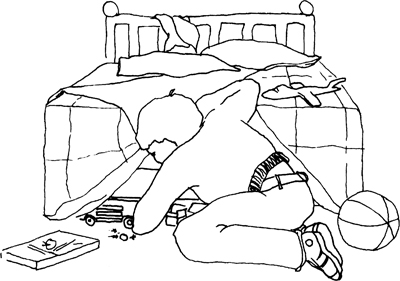

9: Organizing the Bedroom
One of the biggest dilemmas for parents is what can be done about the child’s bedroom. If we leave the care of the room totally to the child, he or she may decide not to clean it, and learn to accept it messy—which is hard on the child’s self-image (and future spouse or roommates). If the parent cleans the room for the child all of the time, the child will learn to like it clean, but expect someone else to clean it. Neither of these attitudes is healthy. Adopt the theory that it is better to help children with their rooms so they learn to like order and feel good about themselves, than to withdraw, close the door, and allow them to live in a mess.
Assume that children like a room to be clean. You can tell because as soon as a room has been cleaned the children want to play there. If we have just finished cleaning the kitchen, someone wants to make cookies. After straightening the family room, they want to start a puzzle or bring out the building blocks. Although children like the good feeling of living in a clean room, they are often too immature to know how to keep it that way. Adult assistance is needed to teach, motivate, and insist that a certain minimum level of cleanliness be maintained.
The first thing to do to help the child organize the bedroom is to evaluate the reasons for the problem. Take thirty minutes, go sit down on the floor of your child’s bedroom, and brainstorm causes and possible solutions. (Have a tablet and pencil with you.) Look at the room from the child’s point of view—that’s why you are sitting on the floor. In evaluating the room, look for ways to (1) cut down the quantity of items to a manageable number for the age and maturity of the child, (2) arrange the room to make it as easy as possible for the child to pick up and clean, and (3) make a definite place for everything in the room.
Cut down the quantity. Consider the structure and physical limitations of the room. Is there too much in the room? If four boys are sharing one room, it is obvious that each can not have as many things as a single child. Is there some way part of the child’s belongings could be stored elsewhere? Even better, does he need all of these things? Maybe getting rid of part of them would simplify his life. It is sometimes easier for parents to keep their bedroom in order because they have other places to store treasures and equipment, but the child may be keeping all of his belongings in his bedroom. Given his immaturity, asking him to go clean his bedroom is about like telling the parent to go clean K-Mart after a giant end-of-season sale. Perhaps you could help this child store part of his things and discard another part of them. After it has been out of sight for a while, he may realize he really doesn’t need it and it could be disposed of at a garage sale or given to Santa’s Workshop. Asking yourself these questions can be very enlightening, as one mother whose twenty-three-year-old daughter had an atrocious-looking bedroom discovered. She had enough stuff crammed in her bedroom to fill a house—wedding gifts left from a broken marriage and all the equipment for a new baby. Once the problem was identified, they worked together to box up most of the things and store them for a time.
Check the room arrangement. While you are sitting there on the floor, look for ways the room could be arranged to make it easier for a little person to manage. What about the bed? Are the sheets, blankets, and bedspread manageable, or are they the ones adults think cute or pretty, but that are hard for a child to make up neatly? Perhaps a bedspread with long, horizontal cording that marks the side edges of the bed or a design showing how far over the bed the bedspread should be is better. Some children have a washable quilt that can easily be pulled up rather than having a top sheet and bedspread with it. The child can make it by just crawling up to the head of the bed, pulling up the cover, smoothing it, and slithering out. If you have enough room, pull the bed away from the wall for easier bed making. As you are looking for ways to make the room arrangement easier, ask, “Can the child hang up his own coat and robe?” If not, maybe hooks would be easier than hangers. You will probably want a wastebasket and some kind of clothes hamper in the room. Shoe boxes in the drawers make terrific dividers to separate socks, underwear, belts, and pajamas. As you sit on the floor evaluating, you will come up with some good ideas, but don’t forget to ask for the child’s opinions, too.
Create a place for everything. A child needs adult help doing this. Go through the following list and check items that still need a resting place. The two-year-old’s bedroom will look a bit different than the seventh grader’s, and the child in a room by himself will have more flexibility than children sharing a room. Make these suggestions fit your circumstances.
![]() Is there a place to sleep that the child can manage?
Is there a place to sleep that the child can manage?
![]() Is there a place for hanging clean clothes? Normally, this would be a closet. Is the rod low enough? If you don’t want to alter the closet permanently, hang a broom stick from the higher rod with ropes. The younger child can pull clean clothes off the hangers, but it is a more advanced skill to put them back on a hanger. At this age, they are usually only wearing clothes for one day and then putting them in the laundry, but what about the robe, coats, and sweaters that don’t need washing every time? Perhaps hooks would be best. Some children don’t need a closet because everything they wear can be folded.
Is there a place for hanging clean clothes? Normally, this would be a closet. Is the rod low enough? If you don’t want to alter the closet permanently, hang a broom stick from the higher rod with ropes. The younger child can pull clean clothes off the hangers, but it is a more advanced skill to put them back on a hanger. At this age, they are usually only wearing clothes for one day and then putting them in the laundry, but what about the robe, coats, and sweaters that don’t need washing every time? Perhaps hooks would be best. Some children don’t need a closet because everything they wear can be folded.
![]() Is there a place for out-of-season clothes and clothes not yet grown into? So often, because the child doesn’t need all the closet space for current clothes, we hang the out-of-size and out-of-season clothes in the closet too, but this can create managing problems. Try boxing up these extra clothes in sturdy fruit boxes and storing them in the top of the closet or some other area like the laundry room.
Is there a place for out-of-season clothes and clothes not yet grown into? So often, because the child doesn’t need all the closet space for current clothes, we hang the out-of-size and out-of-season clothes in the closet too, but this can create managing problems. Try boxing up these extra clothes in sturdy fruit boxes and storing them in the top of the closet or some other area like the laundry room.
![]() Is there a place for shoes and boots? Will their place be under the bed? Is there unused space at the end of the closet that could be fitted with little shelves?
Is there a place for shoes and boots? Will their place be under the bed? Is there unused space at the end of the closet that could be fitted with little shelves?
![]() Is there a place for dirty clothes? You would be surprised how many adults expect children to carry their dirty clothes to a central clothes hamper in the bathroom or downstairs to the wash area every time they undress. Try putting a container like a hamper, large wastebasket or box covered with wallpaper conveniently in the room or closet.
Is there a place for dirty clothes? You would be surprised how many adults expect children to carry their dirty clothes to a central clothes hamper in the bathroom or downstairs to the wash area every time they undress. Try putting a container like a hamper, large wastebasket or box covered with wallpaper conveniently in the room or closet.
![]() Is there a place for folded clean clothes? Usually the child has drawers for clean clothing. What about hats and gloves? Perhaps a dish pan on the closet shelf or hooks by the back door. Some families have a special tradition of putting the pajamas away under the bed pillow or in a zip-up stuffed animal. Help the child remember the system of organization by labeling the shelves and drawers. If you have many children in your family, organize every chest of drawers the same way, such as: top drawer, treasures; second drawer, pajamas, undies, and socks; third drawer, pants and shirts; and fourth drawer, junk. One more tip: Make it an annual tradition to clean out the drawers by using the wrapping paper from the child’s birthday gifts to line the drawers. The excitement of Christmas can motivate children to clean closets and drawers. “Let’s make room for new gifts. Can we give some of these to a family in need?”
Is there a place for folded clean clothes? Usually the child has drawers for clean clothing. What about hats and gloves? Perhaps a dish pan on the closet shelf or hooks by the back door. Some families have a special tradition of putting the pajamas away under the bed pillow or in a zip-up stuffed animal. Help the child remember the system of organization by labeling the shelves and drawers. If you have many children in your family, organize every chest of drawers the same way, such as: top drawer, treasures; second drawer, pajamas, undies, and socks; third drawer, pants and shirts; and fourth drawer, junk. One more tip: Make it an annual tradition to clean out the drawers by using the wrapping paper from the child’s birthday gifts to line the drawers. The excitement of Christmas can motivate children to clean closets and drawers. “Let’s make room for new gifts. Can we give some of these to a family in need?”
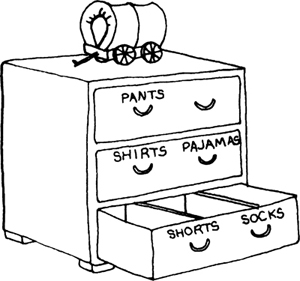
![]() Is there a place for trash?
Is there a place for trash?
![]() Is there a place for books? Perhaps the answer is a headboard with a bookcase, a set of brick-and-board shelves, or shelves in the closet. If you want the child to read for pleasure, have a place for books in the bedroom.
Is there a place for books? Perhaps the answer is a headboard with a bookcase, a set of brick-and-board shelves, or shelves in the closet. If you want the child to read for pleasure, have a place for books in the bedroom.
![]() Is there a table or desk? It is especially important, after the child has entered middle school or junior high, to have a place to do homework; however, it could be done in another designated area in your home.
Is there a table or desk? It is especially important, after the child has entered middle school or junior high, to have a place to do homework; however, it could be done in another designated area in your home.
![]() Is there a place to put school books and pending homework?
Is there a place to put school books and pending homework?
![]() Is there a place to keep finished papers and reports? Maybe a real file cabinet or just a box in the closet is the solution.
Is there a place to keep finished papers and reports? Maybe a real file cabinet or just a box in the closet is the solution.
![]() Is there a place to keep toys? Except for large toys, toy boxes are the worst possible storage. Every time the children want a toy, they dump the whole box and make a big mess. Games and puzzles with many pieces seldom get back together after being dumped in a toy box. Consider separating the games, building blocks, and puzzles into bags (net bags like the ones grapefruit come in are terrific), or boxes. Put a large rubber band around the box in case it should be dropped, so everything doesn’t come out. Buy inexpensive sewing elastic and tack the two ends together to make your own sturdy elastic bands. Hooks in the closet, a pegged mug rack, peg board, or game tree (like coat tree but with hooks all the way down the pole) can hold these toy bags. For stuffed animals, a suspension pole could be set in the corner, holes drilled for hooks, and each animal, with a ribbon around its neck, hung from the pole. Or vertically hang a long, two-inch wooden dowel from a plant hook in the ceiling. Screw cup hooks into the wood on which to hang toys. Secure a fishing net between two walls in a corner of the room as a hammock for dolls and animals.
Is there a place to keep toys? Except for large toys, toy boxes are the worst possible storage. Every time the children want a toy, they dump the whole box and make a big mess. Games and puzzles with many pieces seldom get back together after being dumped in a toy box. Consider separating the games, building blocks, and puzzles into bags (net bags like the ones grapefruit come in are terrific), or boxes. Put a large rubber band around the box in case it should be dropped, so everything doesn’t come out. Buy inexpensive sewing elastic and tack the two ends together to make your own sturdy elastic bands. Hooks in the closet, a pegged mug rack, peg board, or game tree (like coat tree but with hooks all the way down the pole) can hold these toy bags. For stuffed animals, a suspension pole could be set in the corner, holes drilled for hooks, and each animal, with a ribbon around its neck, hung from the pole. Or vertically hang a long, two-inch wooden dowel from a plant hook in the ceiling. Screw cup hooks into the wood on which to hang toys. Secure a fishing net between two walls in a corner of the room as a hammock for dolls and animals.
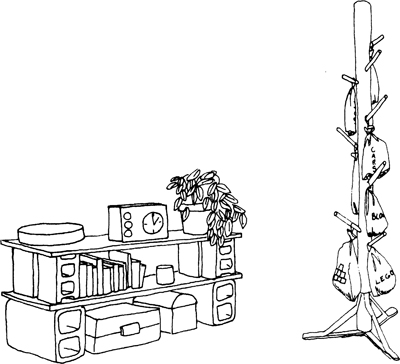
![]() Is there a place for display? Little things that are important to the child need a place, especially if there are younger siblings who might ruin them. A simple knickknack shelf or a corner shelf might be the solution. If there are more items than will fit neatly, rotate them. A bulletin board or clothes line along a wall could be used to display posters or art papers and reports. There are pictures and mementoes that are nice to put in a scrapbook to be shown to future generations. Guide the child in knowing what to keep. Old, blurred, or dark pictures have no value. Label pictures with names and dates for easy identification.
Is there a place for display? Little things that are important to the child need a place, especially if there are younger siblings who might ruin them. A simple knickknack shelf or a corner shelf might be the solution. If there are more items than will fit neatly, rotate them. A bulletin board or clothes line along a wall could be used to display posters or art papers and reports. There are pictures and mementoes that are nice to put in a scrapbook to be shown to future generations. Guide the child in knowing what to keep. Old, blurred, or dark pictures have no value. Label pictures with names and dates for easy identification.
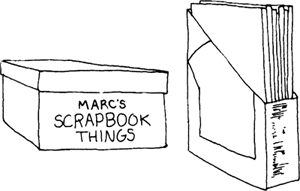
![]() Are there other organizing tools? A mirror, calendar, pencil holder, and pin cushion help a child get organized.
Are there other organizing tools? A mirror, calendar, pencil holder, and pin cushion help a child get organized.
Even though this is quite a long list, you, as parent, will find it will help your child keep things to a minimum so the child can manage them. Don’t let hobbies and collections get out of hand. It may be necessary to re-evaluate your holiday and birthday giving or have a discussion with grandparents.
SET LIMITS
The places you have created to put things can carry an automatic limit. A dish pan or box for school papers is a limit. When the box is full, the child goes through the papers, keeping only the favorites. After storing things for awhile, some of the initial emotional attachment is gone and it is easier for the child to discard them. A bulletin board and knickknack shelf are limiting. When they are full, some of the papers or hobby items need to be stored.
Another important limit to consider is clothing. How often do you wash? Every other day? Once a week? Count the number of days between washings, add a couple, and that could be the limit on how many clothes are out. So often we keep two or three times that many clothes in the closet or chest and it complicates efforts to keep the room clean. Many of the clothes are never worn. We tend to hang as many clothes in the closet as the rod will hold rather than setting the limit on the number the child can manage. Perhaps you can rotate part of them. Some people find it best to keep out-of-season or out-of-fit clothes in fruit boxes in the top of the closet or under the bed. It is so hard to clean with more, even when there is space available. Involve your child in learning to manage a few things well. When a child isn’t wearing a piece of clothing, suggest possibilities of matching it with other clothes. If they don’t like an article of clothing, don’t complicate life; just take it out.
Limits also need to be set for toys. Think about a rotation system, leaving some of the toys out on the toy shelves for a week or two and then rotating them with different ones that have been stored elsewhere. Young children find old toys carry the freshness of new toys after they have been out of sight for a time.
HELP THE CHILD MAKE THE ROOM ATTRACTIVE
Add something new from time to time—it sparks interest. Give a new set of bed sheets or a bucket of paint for a birthday present. Just changing the furniture around when cleaning gives a feeling of newness and motivates the child to keep it clean for a few days. The child’s bedroom doesn’t have to have everything new or look like a magazine picture, but a change gives a boost to the child.
DO NOT THROW AWAY A CHILD’S BELONGINGS WITHOUT ASKING
One mother said she has her seven-year-old son’s bedroom under control. While he is at school, she goes through his things, throws out the junk, and cleans the room. To do it for him is only a temporary solution. It is not teaching him the skill of managing his possessions; he needs practice at letting go of things, at making those decisions. Heaven forbid if that child hasn’t changed before he gets to be an adult, and worse yet, if he should marry one of our daughters! Set up limits in the child’s bedroom and then guide him in making decisions about what to keep and what to eliminate. After the child is five or six, include him in throw-out decisions. One Air Force family that moved about every two years had the motto “If it hasn’t been used since the last move, out it goes.” Even when you have the space, you are not doing the child a favor by saving everything, as learned by a young couple who just moved into their first home. It was a small, two-bedroom bungalow, just right for them and their new baby. But the man’s parents drove up with a full trailer to deliver. They had saved every toy and piece of clothing he had ever owned as a boy—giant model airplanes, an eight-foot soap-box racer, and so forth. The couple’s solution was to build a garage. Stop and think. Just because your child owns and likes something now, that doesn’t mean he wants to carry it around with him for the rest of his life. Guide the child in keeping a few treasures and turning loose of the other things after their season of interest.
HELP THE CHILD CLEAN THE BEDROOM
A messy room for several days signals a need for parental help in cleaning and organizing. Most, although not all, children can handle their own bedrooms by age fourteen, but even after that age, they occasionally enjoy parental assistance. At about five or six years of age, when children start school and when they get more involved with friends, they start collecting more things, they receive nicer gifts that last longer, and they begin having trouble keeping the room clean. At this time, there is a great need for parental consistency. The parent need not insist that the child’s room get forty-nine points on a fifty-point inspection sheet every day; very few adults, even, live that way. Help the child do a little minimum maintenance (pick up, make bed, take care of clothing) every day, and give the room a good cleaning, with vacuuming and dusting, once a week, maybe on Friday afternoon or Saturday morning. This tidy atmosphere is good for the child’s self-image, it says “I am neat” and it pleases Mom and Dad. This attitude doesn’t bind the child down to the perfection of always having to keep everything put away. There is much more to life than a clean house, but a tidy atmosphere frees one in many ways to do other things, especially fun, creative things.
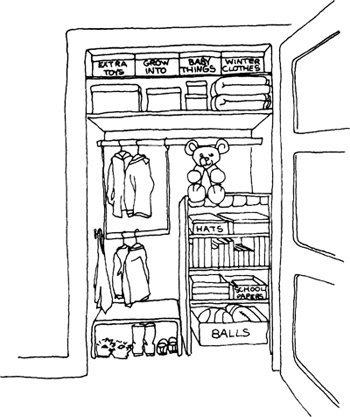
Help the child learn a cleaning system and divide the cleaning into small categories so that he can see progress. Children are capable of making a bigger mess than they can clean up; cleaning up is a more advanced skill. Have them start with the biggest thing first. Ask, “What is the biggest thing in your bedroom?” (Probably the bed.) “Let’s clean if off first and make it.” After the bed is made, both parent and child can see progress—a measurable success. What is the second biggest category that needs to be picked up? Perhaps the books or dirty clothes. Sometimes it is fun at this point to pick things up by color, “Now let’s pick up everything that is red” and move on through other colors.
Take the attitude that this is the child’s room and he or she is the manager, and the parent is the “consultant.” Don’t be afraid to ask “What would you like me to do?” but leave the child in charge. What you are after is more independence, not dependence. Continue guiding the child with the cleaning. It is more rewarding to do a complete pick-up before digging into the real cleaning procedures like dusting, washing windows, or straightening drawers. When the energy starts to wane, there will be something to show progress and motivate to completion. The theory is to work from outside to inside areas. If room cleaning is too unpleasant or takes too long, the child will procrastinate the next cleaning for an even longer time, a self-defeating cycle because the mess will be worse.
Encouragement and positive statements are the major reasons for the parent being with the child during cleaning periods. Point out the progress by comparing with the beginning mess, but don’t turn the clean room into a moral issue. Do not say, “You are a bad girl when your room is messy.” Also point out progress by saying, “See how nice the books look when they are all on the shelf!” or “Just closing the closet door makes quite a difference, doesn’t it?” or “It’s more fun to play in this clean room” or “Doesn’t it make you feel good inside to have this all done?” or “We’re halfway finished.”
The two-point method for putting clothes in a hamper can be lots of fun and motivate your children to pick up. If the garment goes into the hamper when tossed, with nothing sticking out, you get two points. Instead of starting Lecture Number Thirty-eight about clothes all over the floor, just pick up a sock, toss it in the hamper, and announce, “I get two points.” Most children pick up on this very quickly and want points too, and try to make the basket. From then on, the parent keeps score as the child picks up the clothes. If the item is hanging over the edge, only one point is given. (This is a method of giving immediate positive verbal rewards after each effort.) As a parent, you won’t mind losing three-to-ten at this game because you are really the winner; the child has picked up the clothes, as you intended in the first place. The child will probably carry on the game even when the parent isn’t there to prompt it, and putting clothes in the hamper will become a habit. Sometimes this little game works for Mom and Dad’s clothes, too.
Learning to keep the bedroom neat can be a giant time-saving habit, redeemable throughout life. By following the five principles listed on the 7,500 Minute Certificate, one can save thirty minutes a day. A big payoff for daily effort!
7,500 Minute Certificate
Valid to bearer only if the following rules are followed:
1. Keep your room simple. Make a place for everything.
2. Store the things you are not using and the clothes you are not wearing.
3. Keep most accessible space for most-used items.
4. Make your bed first thing every day.
5. No halfway spots. Put it away while in hand.
6. Give your room a five-minute pick-up every day.
Certificate renewable every year of your life. Value is in time saved to do things you want to do.
What about the child who is very, very messy? It might help to know that only one child in five is born neat; the rest have to be taught. It will take patience and, even though it sounds discouraging, you may have to stick with helping the young child clean for several years, not just weeks. Carefully look for the possible cause of the problem, because it could be that the room is only a symptom of other problems. At about twelve years of age, some children go through a typical stage when they rebel about keeping up the bedroom. Go back and ask yourself these questions: Are there more things in the room than the child can manage? Am I giving positive verbal rewards? Is the child lacking in skill? Maybe it is the adult attention the child is seeking and this is the child’s way of getting it. Don’t use the haunting phrase “If you can’t keep your bedroom clean now, how can you handle a whole house?” You could be building future failure. Keep trying, never give up, but don’t nag or threaten. Continue looking for the incentive that will motivate now.
Sue Monson found a formal inspection sheet for older children helpful in establishing a clear standard and teaching exactly what was expected. She took the military approach one Friday in a desperate attempt to improve the bedrooms. After making a surprise check of each bedroom, she posted the scores on the doors. The “notice” included points awarded for each area of the room with comments like “Better luck next time!” and “You can only go up from here!” The scores showed the rooms were a mess. Of the fifty possible points, Mom and Dad scored the highest, a whopping fifteen points. The inspection sheet (see example that follows) taught everyone two things: to know the standard required and to take notice of the dirt and clutter. Since the children had not been at home when the surprise check was made, it brought on a lively discussion—a new approach to “go clean your room.” When Sue told the children they could inspect their parents’ room, they squealed and began planning to play the role as the toughest sergeants around, making the project seem fair and acceptable.
With the chart, the inspection could be completed in five minutes. The exact time of each upcoming inspection was written on the form, giving several days’ notice. Sue found that the children’s examination of the master bedroom meant a white-glove type inspection and she had to labor diligently to pass. Treats were given for scoring from forty up to the possible fifty points. These prizes were kept very simple: a candy bar, an old motor found at a garage sale for the eleven-year-old to disassemble, or a special book from the library. She wanted the biggest reward to come from meeting the standard set on the inspection sheet, not from the token prize. Make this inspection sheet work for you. If toys and a toy shelf are the problem, add them to the sheet. Change the categories to fit the particular room you will be inspecting. If there are fifteen books sitting around on the nightstand, a limit of three books could be set. Adjust the inspection sheet to meet the situation in your home.
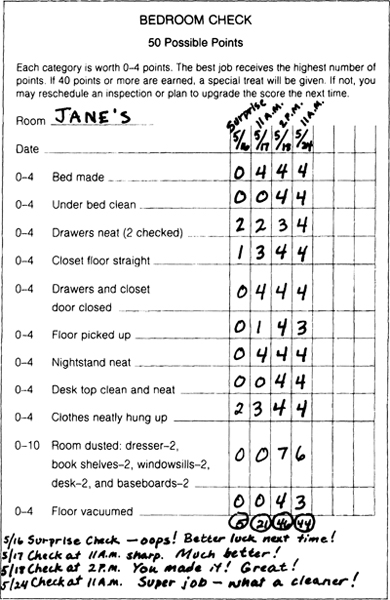
Children have different levels of motivation for keeping a room clean. We would hope that when they have their own homes, the inner motivation will increase because it is theirs. For now, you can help them organize their bedrooms and succeed in keeping them clean. If it comes to a clash, remember, the child’s membership in your family is more important than a clean bedroom. If you can, give them the skills of housekeeping now, so that when or if they want to, they can employ them. If they won’t accept this responsibility now, perhaps they will be ready to do so later. Two-year-old little Sarah was taught to say, “I can handle anything, I can handle anything.” Such an attitude in life gives enough courage to say, “I will give it another try.”